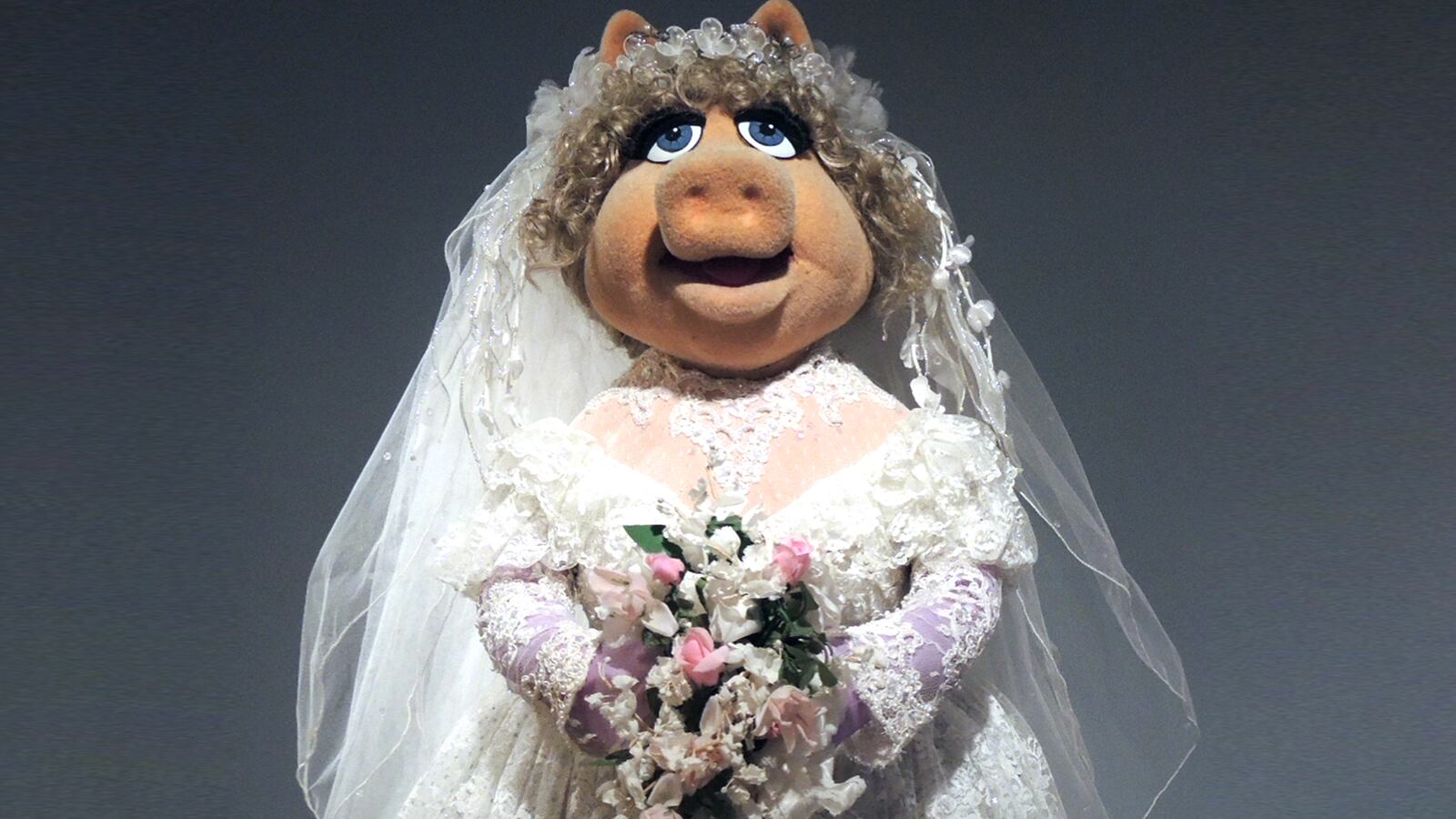“Dear Kermit the Frog,” begins the letter from a young fan, framed on the wall of the new Jim Henson Exhibition at the Museum of the Moving Image in Queens. “How is show business? When are you and Miss Piggy getting married? Tell Miss Piggy I saw a bride dress.”
I’d guess from the handwriting that the scribe was 6 or 7 years old. But at the top of the page is handwriting that I recognize—my mom’s, making a careful note of just how many letters like this there were the pile of mail requiring her attention. Because when I was growing up, my parents’ job was answering all the fan mail the Muppets received.
Yes, really. It was a job that started small, something easily accomplished by my mother, mostly in her spare time, in our two-bedroom apartment. But when The Muppet Show (1976-1981) really took off, well, the sacks of fan mail started to fill our home, and it became a full-time occupation for both my parents—and opening envelopes and sorting letters was the way I earned my pocket money as a kid.
My folks worked for the Muppets until they both retired; Kermit, Piggy, Fozzie, Rowlf, and all the crew loomed large in my childhood: but as this wonderful exhibition reminds us, that doesn’t actually make me very unusual at all, despite my parents’ rather unusual profession.
A bitter wrangle between Steve Whitmire—the voice of Kermit the Frog since Jim Henson’s untimely death in 1990 at the age of 53—and the Disney Corporation has recently brought the iconic amphibian into public consciousness in an unfortunate way, it must be said. (Disney acquired the Jim Henson Company in 2004.)
Whitmire was dismissed from the work to which he gave all his adult life; Brian Henson, Jim Henson’s son, has entered the fray by supporting Disney’s decision, which was based on Whitmire’s behavior both in the role of Kermit and within the corporation.

It’s too bad: because as the show at the Museum of the Moving Image reminds visitors, Henson’s work was all about cooperation and collaboration. “All the work that I do,” Henson says in a clip that runs on a loop near the show’s exit, “is very much a group effort.”
But that group effort encompassed a great deal more that just the Muppets we remember from The Muppet Show, or from Sesame Street, which is still going strong after nearly 50 years.
This permanent exhibition, mounted thanks to extraordinary cooperation between the Henson family, The Jim Henson Legacy, The Jim Henson Company, the Sesame Workshop, and The Muppets Studio—with support from the city of New York—offers a remarkable overview of Jim Henson’s unique vision: a vision that transformed entertainment and popular culture.
If it seems like a broad claim to say that Henson’s work is an absolute cornerstone of popular culture, consider the 21st-century blurring between advertising, entertainment, and art, and remember that Rowlf the Dog got his start in 1962, advertising Purina Dog Chow.
Sesame Street made television for children entertaining for grown-ups in a way it had never been before: Would The Simpsons exist without the work of Henson and his crew?
Kermit: a Frog From Mississippi
Jim Henson was born in Greenville, Mississippi, in 1936, into a close-knit family. His maternal grandmother was an accomplished painter and seamstress, and was a powerful early influence on his life.
Artifacts donated by the Henson family—unpublished cartoons, a silk-screened ad for a poster-making business that Henson got going when he’d just turned 20—show that both his artistry and his enterprise were apparent from an early age.
By his senior year in high school, by which time the family had moved to Maryland, he was already working as a puppeteer, having successfully auditioned for a local television show.

He recognized very early on in his life that television was the medium of the future: “I badgered my parents until we got [a television],” he said. “I mean, it was a real campaign… I thought it was incredible. I still do… I’ve always been in love with television.”
He traveled to Europe in 1958 and saw a great many puppet shows on the trip. It was then that he realized that puppetry could be an art form, and one uniquely well-suited to television.
What’s so striking about the early work on display at the museum is that his sensibility is apparent right from the get-go. The first Muppet to greet the visitor to the exhibition is, of course, Kermit: one of the 180 Muppets carefully restored by the Jim Henson Creature Shop and the Museum in preparation for the exhibition.
Kermit appears here in the green felt incarnation we all know and love; but Kermit got his start as early as 1955 as a light blue-green abstraction. But the amorphous forms of his early shows such as the puppets of Sam and Friends (1955-1961) already reveal the remarkable ability the Muppets have to take on character from what seems like thin air: a round head, a pair of googly eyes, a tuft of fake fur.
There’s a wonderful interactive “create your own Muppet” display, where you can stick eyes and a nose on a generic Muppet and see how your creation looks on a television monitor.

This display includes important advice from Rollie Krewson, master puppet builder for the Jim Henson company Creature Shop: “The placement of the eyes is really crucial,” she says. And so it is: One moment there’s just a round felt head; the next minute, someone’s looking back at you.
It is also clear from the exhibition just how early Henson began to gather around him the team which would make the Muppets beloved around the world. He married his fellow performer Jane Nebel in 1959; Jane Henson, who died in 2013, was his sounding-board in life and, after Henson’s death, the guardian of his legacy.
Frank Oz, who would perform iconic characters such as Cookie Monster, Grover, Miss Piggy, and Fozzie Bear, joined the company in 1963 at the age of 19; the natural, wonderful performing relationship between Oz and Henson is brilliantly displayed in a video clip of a test reel made for The Muppet Movie in 1978.
Up until that point the Muppets had only ever been filmed in studios: No one knew what they’d look like outside. So here are Kermit and Fozzie leaning on a tree, with a herd of cows behind them—and Kermit starts to explain to Fozzie that they have to do this because Fozzie is not a “real bear.”
Fozzie is stunned by this news, and clearly hurt—the banter goes back and forth, hilarious and touching, and clearly completely unscripted. It also offers more evidence of the true magic of the Muppets. Somehow, the knowledge that they were not “real” never damaged their authenticity. The truth of art transcends felt and fabric and wire.
The breadth of Jim Henson’s imagination apparent throughout. There is an extraordinary short film, Time Piece, from 1964, which has no puppets in it at all but includes surreal scenes of gorillas on pogo sticks and Jim Henson jumping off a pier dressed in a tuxedo; it was nominated for an Academy Award.
David Bowie’s costume from the 1986 cult film Labyrinth is here; and intricate puppets and drawings from The Dark Crystal (1982).

This collaboration between Henson and the artist Brian Froud has had an enduring influence: and now a prequel series is underway with Netflix. Louis Leterrier, director of Now You See Me, will executive produce the series and direct; the Jim Henson Company will produce the show; a teaser trailer is already up online.
Curator Barbara Miller and Wendell Walker, head of Exhibition Design for the Museum of the Moving Image, have done a terrific job of bringing Henson’s life and work, and the lives and work of his colleagues, friends, and collaborators to life.
This is an exhibition which offers something for everyone—though, to be fair, I’d say that if you’re going to bring your kids, ages 8 and up would get the most from it.
It is richly detailed but also sweet and funny and full of irony, just as the Muppets always were and are. (And if you can’t make it to Queens, a traveling version of the exhibition opened on May 20 at the Museum of Pop Culture in Seattle, and will continue to move around the country.)
And as for those fans whose letters arrived at my parents’ house all those years ago? Well, they’re just as active and enthusiastic as ever, I’m pleased to say. I was thrilled to learn that $150,000 of the cost of this exhibition was raised on Kickstarter by 2,000 people who knew—as we all can see now—that Jim Henson’s work deserved a permanent place in the Museum’s collection. It’s always time to play the music and light the lights.
The Jim Henson Exhibition opens today, Saturday, July 22, at the Museum of the Moving Image, Astoria, Queens. Details here.






